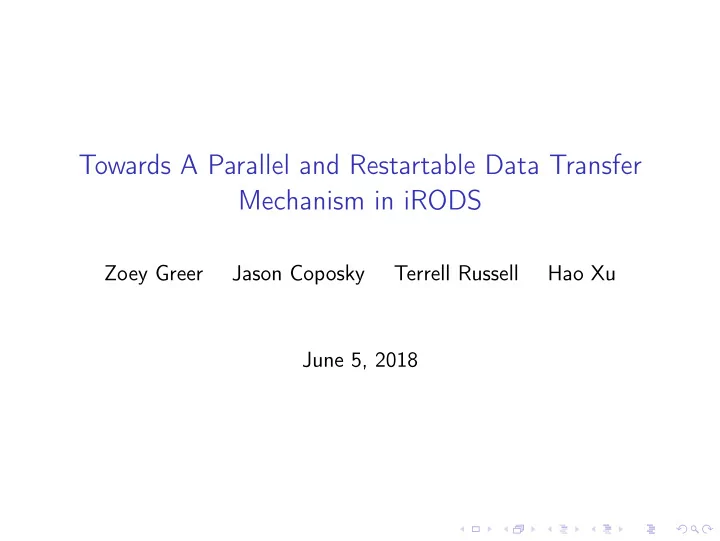

Towards A Parallel and Restartable Data Transfer Mechanism in iRODS Zoey Greer Jason Coposky Terrell Russell Hao Xu June 5, 2018
Introduction Current iRODS implementation supports limit parallel transfer and restart capability. We introduce a design that extends current iRODS to support multiple tasks related to parallel transfer and restart in a unified, general solution. We want to ◮ extend rather than completely rewrite the current iCAT. ◮ put, get, replication symmetrically. ◮ build API up from microservices. ◮ support parallel transfer ◮ support distributed storage of data. ◮ support partial replicas. ◮ support automatic restart. ◮ support partial synchronization. ◮ support distributed strorage of ICAT efficiently
The Design: Current 1-n 1-1 resource data object replica Figure: Entity-Relationship Diagram
The Design: Parallel and Restart 1-n data object block m-n 1-n n-1 resource replica Figure: Entity-Relationship Diagram
Block Level ◮ Block level put get client to server y y client to client n n server to server y y/n ◮ Data Object level: put-get-replicate
Data Types type Error type Range -- = (Int, Bitmap) type Block type Data_object -- = (Path, Timestamp) type Replica -- = (Data_object, Host, Replica_num)
block_put Push a block to a resource using block_put . In the following, we use a default block size of 4MB. block_put : (Replica, Range, [Block]) -> () This can be used in various operations.
data_object The put operation is initiated by the client by the data_object operation. data_object : Data_object -> [(Replica, Range)] This request can be to any server.
replica For each resource, the client start putting blocks into replicas using the replica operation. replica : (Replica, Range) -> Range The returned range is a range of existing blocks on the resource in the input range. Based on returned range, the client sends the blocks to the resource.
block_get Pull a block from a resource using block_get . block_get : (Replica, Range) -> [Block]
put client server1 server2 data_object [(server2,0-128)] replica 0-64 block_put(64-128)
get client server1 server2 data_object [(server2,0-128)] replica 0-128 block_get(64-128)
replicate client server1 server2 server3 data_object [(server2,0-128)] replica 0-128 replica 0-64 replicate block_put
Storing incomplete replica blocks metadata Figure: Incomplete replica Metadata contain Replica and Range of available blocks
Parallel put replica 1 replica 2 metadata 1 metadata 2 blocks Figure: Multi-part put
Parallel get replica 1 replica 2 metadata 1 metadata 2 blocks metadata 3 Figure: Multi-part get
Recommend
More recommend